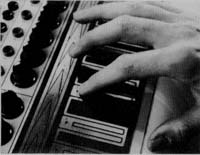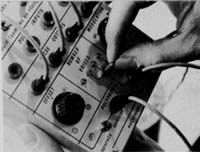◊ Historic Buchla Modules
Buchla pages > Buchla 200 modules
Buchla pages > Buchla 200 modules
Around 1970, Buchla launched the Model 200 series, sometimes referrer to as the "Electric Music Box". Elaborating the ideas from the 100 series, the 200 series added complexity and depth, and introduced a wider variety of kinesthetic controllers that continued to be a central concern of Don's.
Following the launch of the 200 modules, Don increasingly focused on incorporating computer control to analog modular synthesizers — in both the 500 and 700 series, and in retrofitting computer and MIDI control in the 200e series still produced by Buchla U.S.A.

Here's Don's description of the 200 system, and his elaboration on voltage control:
THE ELECTRIC MUSIC BOX, Series 200, is a comprehensive collection of precision electronic modules for generating and processing sound. It is a system designed for those who desire simultaneous control of many aspects of sound and who demand professional standards of performance and reliability.
 The system features unusually high functional
density, extended dynamic range, self-contained monitoring (preview) facilities,
and unrestrained expandability. Interesting new techniques for polyphonic signal
generation, dynamic spectral and timbral modification, complex pattern
generation, and control of spatial location and movement are introduced.
Organization is optimized for compactness, ease of access, and ready
comprehension.
The system features unusually high functional
density, extended dynamic range, self-contained monitoring (preview) facilities,
and unrestrained expandability. Interesting new techniques for polyphonic signal
generation, dynamic spectral and timbral modification, complex pattern
generation, and control of spatial location and movement are introduced.
Organization is optimized for compactness, ease of access, and ready
comprehension.
Connections within the system are made with color-coded patchcords, for maximum graphic visual feedback, zero crosstalk, optimal utilization of panel space, and unlimited flexibility and expandability. A clear and consistent distinction is maintained, both in modular function and in interconnection, between signals (the raw material of electronic music), control voltages (defining parametric structure, e.g. pitch, timbre, intensity, location), and timing pulses (defining event times and durations).
 Components of the Electric Music Box are designed
to interface readily with digital computers. All musical parameters are voltage
(and therefore computer) controllable; necessary logic supplies, tracking
adjustments, and digital outputs are incorporated; and the prerequisites of high
stability and predictability are met. Even the smallest Electric Music Box can
be expanded to a hybrid digital-analog system incorporating programmed patching,
multiple arbitrary function generation, and powerful editing and performance
capabilities.
Components of the Electric Music Box are designed
to interface readily with digital computers. All musical parameters are voltage
(and therefore computer) controllable; necessary logic supplies, tracking
adjustments, and digital outputs are incorporated; and the prerequisites of high
stability and predictability are met. Even the smallest Electric Music Box can
be expanded to a hybrid digital-analog system incorporating programmed patching,
multiple arbitrary function generation, and powerful editing and performance
capabilities.
The Electric Music Box can be configured to serve a variety of applications, including electronic music composition and performance, music education, psychoacoustic studies, environmental control, special effects generation, bio-feedback research, and video synthesis. Buchla and Associates can supply systems, auxiliary equipment and complete studios to suit these and other applications. For further information, please contact Buchla and Associates.

Voltage control may be defined as the use of electrical voltages to determine the instantaneous values of musical parameters. The concept was introduced to the electronic music studio in 1963 (at the San Francisco Tape Music Center) and was instrumental in making electronic music composition a real-time process (instead of a tedious tape-splicing exercise).
Voltage control has been generally applied to only two variables -- pitch and amplitude. And the sources of control voltages have been limited to relatively simple function generators, subsonic audio sources, and monophonic, dynamically unresponsive organ keyboards.
The Electric Music Box extends voltage control to virtually every musical dimension. The system enables voltage control of pitch, amplitude, waveshape, filter parameters, envelope characteristics, modulation, reverberation, and quadraphonic location.
Complementing this diversity of voltage-controlled parameters is a variety of control voltage sources. Touch-sensitive and electro-mechanical keyboards respond to the dynamics of playing; sequencers and envelope generators produce complex transient or cyclic patters. External signals interact through envelope and pitch detectors; the element of uncertainty is introduced by two specialized random voltage sources.
In the Electric Music Box, a consistent distinction is maintained between control voltages (which define musical structure) and signals (the raw material of electronic music). This treatment of control voltage as an important, separate entity contributes significantly to the conceptual clarity and excellent technical performance that characterize the Electric Music Box.
NOTICE: The text, images, graphics, and other content of this website related to Don Buchla's legacy synthesizer designs is made available under the Fair Use Doctrine of the US Copyright Office. Fair Use limits the use of this information to personal, educational, and scholarly purposes (including right-to-repair, where applicable). It may not be used as the basis of commercial or for-profit works. Printed Circuit Boards may be purchased and assembled for your personal or educational use, but may not be manufactured and sold as "Buchla" products.